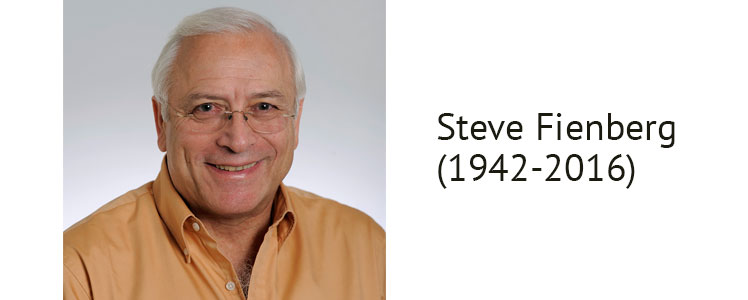Remembering Steve Fienberg (1942-2016)
Statistician who campaigned for better science in court

This story first appeared in the journal Nature
Stephen Fienberg was the ultimate public statistician. One of his most significant social contributions was making a convincing case that bad science sends innocent people to prison. He used statistics to assess the foundations of legal evidence—fingerprint analysis, hair matching, polygraphs—and found them wanting. His work helped to limit the use of shoddy techniques and forced reviews of past cases.
More than most statisticians, Fienberg focused on policy. He improved how the census counted homeless people, promoted data sharing among scientists and assessed online privacy measures. He testified before Congress 15 times, and consulted for numerous federal agencies, working on problems related to health, employment, justice and agriculture. He took part in dozens of US National Research Council (NRC) committees and panels, including chairing the Report Review Committee, and contributed to hundreds of others. In 2015, he was one of 13 scientists convened by the US National Academy of Sciences (NAS) for a summit on the need to improve research integrity in the wake of misconduct scandals and concerns about reproducibility of results.
He also made important theoretical advances in statistics. His 1975 book, Discrete Multivariate Analysis: Theory and Practice (MIT Press), is a canonical approach to the analysis of categorical data—information such as race or size that can be lumped into categories. His work on election polling, replicability of research findings, privacy in digital networks and the application of Bayesian methods were all ahead of their time.
Fienberg was born in 1942. At Canada’s University of Toronto, in his hometown, he studied mathematics and science. For his PhD, at Harvard University in Cambridge, Massachusetts, he worked on an NRC study on the possible association of anaesthesia and postoperative liver failure. Next came a joint appointment in statistics and theoretical biology at the University of Chicago, Illinois. From there, he went to the University of Minnesota in Minneapolis and, in 1980, to Carnegie Mellon University in Pittsburgh, Pennsylvania, where he spent the bulk of his academic career. Fienberg died on 14 December at home with his family in Pittsburgh, after a long battle with cancer.
Between 1982 and 1987, Fienberg chaired an NAS panel which resulted in his 1989 book The Evolving Role of Statistical Assessments as Evidence in the Courts (Springer). At the time, the book received little notice, but he continued to develop this line of work. In 2003, he worked on the NAS report ‘The Polygraph and Lie Detection’, which helped to limit the use of the instrument.
In 2015, he was a senior adviser for a report by the President’s Council of Advisors on Science and Technology that highlighted problems across a range of forensic-science techniques. He also served as the only statistician on the Department of Justice’s National Commission on Forensic Science until his death. He was the driving force behind draft recommendations on the use of probabilistic statements in court; the commission is expected to vote on the recommendations this April.
In many forensic disciplines, examiners link evidence from a crime scene to evidence from a suspect by stating, for instance, that there’s only a one-in-a-million chance that hair from a crime scene and hair from a suspect are not from the same person. In reality, with the exception of DNA testing, there is no research to back such claims: the likelihood of coincidental matches of forensic evidence is unknown. Fienberg’s work helped to bring to light these problems—and the resulting wrongful convictions.
For example, his assessment of what constituted a statistically defensible analysis of microscopic hair comparisons was used by the FBI to review past investigations. In 2015, the bureau announced that more than 90% of the first 500 cases examined had contained erroneous statements in laboratory reports and analysis.
His work is also helping to fill the scientific holes he identified. In 2015, he drew together a four-university consortium to develop a statistical foundation for how examiners should use common sorts of courtroom evidence, such as fingerprints or ballistics data, to match a pattern from a crime scene to a suspect or their belongings.
Fienberg was an indefatigable mentor, replying to students’ e-mails at all hours of the night. He often devoted himself to work that was necessary rather than prestigious. Survey research, for example, is no longer a hot topic for theoretical statisticians because the theoretical underpinnings of choosing a survey sample are thoroughly worked out. However, doing a good survey is difficult, and Fienberg continued to work on problems such as questionnaire design until his death, helping to make surveys more reliable. His modelling techniques have been cited across a range of academic disciplines, and also in reports on human-rights violations presented in war-crimes trials and historical clarification commissions.
In October, Carnegie Mellon hosted a symposium to celebrate Fienberg’s career. One attendee recalled that, when she began work on an NAS panel, she was warned to be prepared to deal with this impossible guy on the review committee who always had difficult questions—Steve Fienberg.
At that same gathering, Fienberg explained how his illness had shaped a new interest. He supervised his own care, combing the literature to find medicines approved for other uses that had shown off-label success in treating cancer. He urged his audience to take up a question that he’d been thinking about: developing rigorous analyses to evaluate the effectiveness of treatments in an age of personalized medicine—one in which more people are doing as Fienberg did and becoming a ‘sample of one’. ■
Robin Mejia did a PhD in biostatistics in May 2016, inspired in part by Steve Fienberg. She now manages the Statistics and Human Rights Program at Carnegie Mellon’s Center for Human Rights Science. e-mail: rmejia@andrew.cmu.edu
